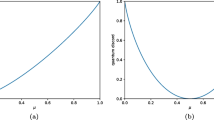Abstract
The methods of quickly achieving the adiabatic effect through a non-adiabatic process has recently drawn widely attention both in quantum and classical regime. In this work ,we study the classical adiabatic shortcut for two- and three-Level atoms by transforming the quantum version into classical one via quantum-classical corresponding theory. The results shows that, the additional couplings between the oscillators can be used to speed up the adiabatic evolution of coupled oscillators. Furthermore, we find that the quantum-classical correspondence theory still holds for the couter-adiabatic driving Hamiltonian for the TQD. This means that, we can obtain the counter-adiabatic driving Hamiltonian for a classical system by averaging over its quantum correspondence in a quantum system. This provides a feasible way to study the classical adiabatic shortcut and the simulation for the quantum adiabatic shortcut in a classical system.
Similar content being viewed by others
References
Rezek, Y., Kosloff, R.: Irreversible performance of a quantum harmonic heat engine. New J. Phys. 8(5), 83 (2006)
Berry, M.V.: Transitionless quantum driving. J. Phys. A 42(36), 365303 (2009)
Chen, X., Torrontegui, E., Muga, J.G.: Lewis-riesenfeld invariants and transitionless quantum driving. Phys. Rev. A 83, 062116 (2011)
Zhang, J., Shim, J.H., Niemeyer, I., Taniguchi, T., Teraji, T., Abe, H., Onoda, S., Yamamoto, T., Ohshima, T., Isoya, J., Suter, D.: Experimental implementation of assisted quantum adiabatic passage in a single spin. Phys. Rev. Lett. 110, 240501 (2013)
Chen, X., Ruschhaupt, A., Schmidt, S., del Campo, A., Guéry-Odelin, D., Muga, J.G.: Fast optimal frictionless atom cooling in harmonic traps: Shortcut to adiabaticity. Phys. Rev. Lett. 104, 063002 (2010)
del Campo, A.: Shortcuts to adiabaticity by counterdiabatic driving. Phys. Rev. Lett. 111, 100502 (2013)
del Campo, A.: Frictionless quantum quenches in ultracold gases: a quantum-dynamical microscope. Phys. Rev. A 84, 031606 (2011)
Chen, Y.H., Shi, Z.C., Song, J., Xia, Y.: Invariant-based inverse engineering for fluctuation transfer between membranes in an optomechanical cavity system. Phys. Rev. A 97(2), 023841 (2018)
Lu, M., Xia, Y., Shen, L.T., Song, J., An, N.B.: Shortcuts to adiabatic passage for population transfer and maximum entanglement creation between two atoms in a cavity. Phys. Rev. A 89(1), 012326 (2014)
Chen, Y.H., Xia, Y., Wu, Q.C., Huang, B.H., Song, J.: Method for constructing shortcuts to adiabaticity by a substitute of counterdiabatic driving terms. Phys. Rev. A 93(5), 052109 (2016)
Deffner, S., Jarzynski, C., del Campo, A.: Classical and quantum shortcuts to adiabaticity for scale-invariant driving. Phys. Rev. X 4, 021013 (2014)
Jarzynski, C., Deffner, S., Patra, A., Subaşı, Y.: Fast forward to the classical adiabatic invariant. Phys. Rev. E 95, 032122 (2017)
From classical nonlinear integrable systems to quantum shortcuts to adiabaticity. Phys. Rev. Lett. 117(7), 070401 (2016)
Jarzynski, C.: Generating shortcuts to adiabaticity in quantum and classical dynamics. Phys. Rev. A 88, 040101 (2013)
Deng, J., Wang, Q.H., Liu, Z., Hä, nggi, P., Gong, J.: Boosting work characteristics and overall heat-engine performance via shortcuts to adiabaticity: Quantum and classical systems. Phys. Rev. E 88, 062122 (2013)
Xiao, G., Gong, J.: Suppression of work fluctuations by optimal control: An approach based on Jarzynski’s equality. Phys. Rev. E 90(5), 052132 (2014)
Polchinski, J.: Weinberg’s nonlinear quantum mechanics and the einstein-podolsky-rosen paradox. Phys. Rev. Lett. 66, 397–400 (1991)
Heslot, A.: Quantum mechanics as a classical theory. Phys. Rev. D 31, 1341–1348 (1985)
Weinberg, S.: Testing quantum mechanics. Ann. Phys. 194(2), 336–386 (1989)
Wu, B., Liu, J., Niu, Q.: Geometric phase for adiabatic evolutions of general quantum states. Phys. Rev. Lett. 94, 140402 (2005)
Zhang, Q., Wu, B.: General approach to quantum-classical hybrid systems and geometric forces. Phys. Rev. Lett. 97, 190401 (2006)
Stone, M.: Born-oppenheimer approximation and the origin of wess-zumino terms: Some quantum-mechanical examples. Phys. Rev. D 33, 1191–1194 (1986)
Gozzi, E., Thacker, W.D.: Classical adiabatic holonomy and its canonical structure. Phys. Rev. D 35, 2398–2406 (1987)
Liu, H.D., Wu, S.L., Yi, X.X.: Berry phase and hannay’s angle in a quantum-classical hybrid system. Phys. Rev. A 83, 062101 (2011)
Chen, X., Lizuain, I., Ruschhaupt, A., Guéry-Odelin, D., Muga, J.G.:
Berry, M.V.: Classical adiabatic angles and quantal adiabatic phase. J. Phys. A 18(1), 15 (1985)
Torosov, B.T., Della Valle, G., Longhi, S.: Non-Hermitian shortcut to stimulated Raman adiabatic passage. Phys. Rev. A 89(6), 063412 (2014)
Wu, S., Huang, X., Li, H., Yi, X.: Adiabatic evolution of decoherence-free subspaces and its shortcuts. Phys. Rev. A 96(4), 042104 (2017)
Acknowledgements
This work is supported by National Natural Science Foundation of China (NSFC) (Grants No. 11875103, 11775048, and No. 11747155), the Plan for Scientific and Technological Development of Jilin Province (Grant No. 20160520173JH), and the Scientific and Technological Program of Jilin Educational Committee during the Thirteenth Five-year Plan Period (Grant No. JJKH20180009KJ, and No. JJKH20181162KJ).
Author information
Authors and Affiliations
Corresponding authors
Rights and permissions
About this article
Cite this article
Chen, S.Y., Zhang, Y.N., Yang, J. et al. Quantum-Classical Correspondence for Adiabatic Shortcut in Two- and Three-Level Atoms. Int J Theor Phys 58, 836–843 (2019). https://doi.org/10.1007/s10773-018-3979-9
Received:
Accepted:
Published:
Issue Date:
DOI: https://doi.org/10.1007/s10773-018-3979-9




